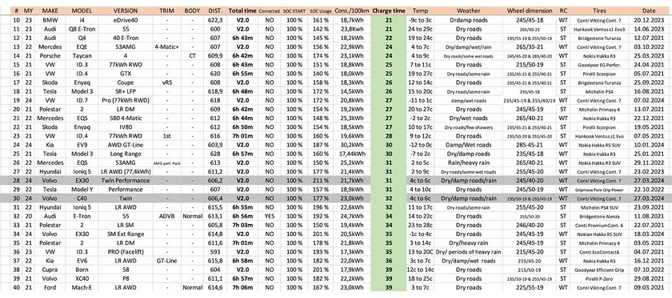The Volvo EX30 faces the Volvo C40 in an autonomy test, and disastrous for both.
The new Volvo EX30 has become one of the most popular options on the market thanks to factors such as its design, its compact body, and a price that, without being revolutionary, is competitive as things are. Now, a channel has pitted it against its older brother, the Volvo C40, in an autonomy test that has not left either very well off.

The test by the Kris Rifa channel, involved a tour of the roads of Norway, covering the distance that separates Oslo from Togstasjon Kristiansand. A total of 650 kilometers that the two models have completed at the same time under the same circumstances.
The objective was to reach the destination in the shortest time possible. In this way, they have used a route planner that has indicated to the C40 that it would have to make two stops while the EX30 would have to make three. But three stops shorter than the two of the C40.
For the test, they have used the most powerful versions of each model, with the EX30 Twin Motor Performance, which has two engines and a combined power of 315 kW (428 HP). Its autonomy remains at 450 km WLTP thanks to a 64 kWh battery, and its price in Spain is 48,995 euros.
The C40 is the Twin Motor version, which has 300 kW (408 HP) with an 82 kWh battery that offers 507 km WLTP. A C40 that the latest update has increased its power to 325 kW (435 HP) and that in Spain has a price of 58,372 euros.
Poor efficiency for the EX30 and C40
One of the first impressions during the tour is the EX30’s range estimate. When starting the march, it indicated that would reach the first stop with 17%, but as it got closer, the figure dropped below 10%.
At this first stage of the race, the C40 seemed more efficient, with an average consumption of 22.2 kWh per 100 km compared to the EX30’s 22.5 kWh/100 km.
After two and a half hours, the EX30 now estimated only 4% charge in its battery when arriving at the first stop, while the C40 indicated that arrived with 18%.
The EX30’s software appears to estimate correctly, it simply cannot deliver with calculations. Because of this, the driver decided to charge earlier than planned to avoid arriving at the first stop with less than a 10% charge.
Another peculiarity of the EX30 is that, unlike most electric cars when its battery drops below 10%. In most other electric vehicles, they connected below 4%. However, the EX30’s charging speeds are reduced if you connect below 10%.
On the other hand, when connecting it above 10%, we see how the power is practical, as announced by the manufacturer, 158 kW, marking 153 kW at 18% battery charge. Something that allows you to get back on the road just 10 minutes after connecting to continue your “career.”
At the end of the journey, the EX30 has achieved an average consumption of 21.7 kWh per 100 km, allowing it to achieve a range of 286 km with a full charge under these circumstances. (63.6% of WLTP autonomy).
The driver has made three stops to charge in the 650 km in total, but the car has only stopped for 31 minutes.
The C40, for its part, finished the route with an average consumption of 23.0 kWh per 100 km, with an estimated range of 329 km. (59.8% of WLTP autonomy). In its case, only 2 charging stops were needed, but each stop was several minutes longer than the EX30. Still, it only spent 32 minutes charging, a minute longer than the EX30.
The C40 arrived first at the final destination with 8% battery remaining. The EX30 arrived just a minute or two later with 0% battery.
Again, this has to do with the poor estimation of the EX30’s system, which at the last stop indicated that with the charge level at that moment, it could reach its destination with the remaining 11%. Something that tells us that the EX30 would have needed to make another stop or a longer last one, widening its difference with the C40.
The result is quite bittersweet for the two models, which fail to complete the trip with good consumption, with figures more typical of a large SUV than two compact models. The good news is that the charging system seems quite competitive, and allows you to recover the charge in a few minutes.
Of course, to estimate the load until the next stop we will have to take into account the enormous difference concerning reality in the case of the EX30, which will force us to charge slightly longer than what the system recommends so as not to take us a scare
Consumption that we can compare with the 18 kWh per 100 km that the Volkswagen ID.4 has achieved in the same test, in better weather conditions, the 18.3 kWh of the Skoda Enayq, or the 18.9 kWh of the Tesla Model Y Performance, which is They have also faced low temperatures.

Related Post
